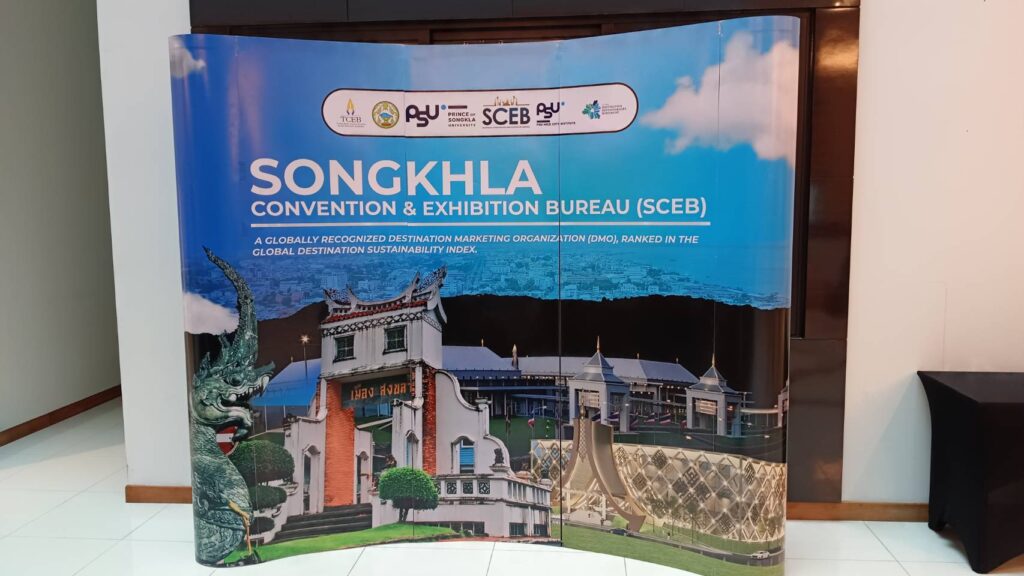
Image courtesy of Songkhla Convention and Exhibition Bureau FB
By Kenny Teng
SONGKHLA, Oct 11: Thailand is positioning Songkhla province as its next southern growth engine, leveraging its strategic location, enhanced infrastructure, and newly established Special Economic Zone (SEZ) to attract cross-border investment and boost regional trade.
Once known mainly as a border trade gateway and weekend getaway for Malaysian tourists, Songkhla is now rapidly transforming into a major economic and logistics hub in southern Thailand.
Strategically located on the north of Peninsula of Malaysia, Songkhla serves as Thailand’s gateway to Malaysia and the wider ASEAN market, connecting the southern provinces to the rest of the region.
Driving Cross-Border Trade
Songkhla Governor Chotnarin Kerdsom said the SEZ targets industries such as logistics, rubber processing, electronics, halal food production, and light manufacturing, building on the province’s strong industrial base and skilled workforce.
He said the SEZ aims to create long-term economic value by linking manufacturing with cross-border logistics and expanding export capacity to Malaysia and beyond.
“The Songkhla SEZ is part of Thailand’s vision to strengthen the southern region’s competitiveness. It will not only generate employment but also support regional supply chains between Thailand and Malaysia,” he told Bernama on the sidelines of the Diplomatic Corps’ visit to Songkhla province recently.
With a population of nearly 1.5 million, Songkhla plays a key role in Thailand’s Southern Economic Corridor (SEC), which aims to enhance economic connectivity between the Gulf of Thailand, the Andaman coast, and Malaysia.
The province’s proximity to Malaysia’s Kedah and Perlis states, along with its access to the Penang logistics network, has positioned it as a natural hub for bilateral and regional trade.
Maintaining Peace, Spurring Growth
Addressing recent perceptions about safety in Thailand’s southern border provinces, Thai authorities have clarified that Songkhla and most of the southern region remain safe for investment and tourism.
Secretary-General of Thailand’s National Security Council (NSC), Chatchai Bangchuad, said the government is committed to resolving long-standing unrest in the deep south, emphasising that most areas are peaceful and are witnessing growing trade and tourism activity.
He stressed that the majority of southern provinces remain calm and economically vibrant, with only a few districts facing isolated security concerns.
Chatchai added that inviting diplomats from economies with strong trade and investment potential for visits helps generate accurate assessments and dispel outdated perceptions.
“Trusted voices like ambassadors can share their first-hand observations with their capitals, leading to more balanced travel advisories and stronger cooperation in tourism and commerce,” he said.
Strengthening ASEAN Trade and Connectivity
Meanwhile, Songkhla has also been selected as one of three provinces to co-host the 33rd SEA Games in December, featuring major competitions such as water sports, martial arts, and traditional local games.
According to the Songkhla Chamber of Commerce, border trade value exceeded 300 billion Baht in 2024 and is expected to rise further as infrastructure and customs facilities are upgraded.
Looking ahead, Songkhla’s ongoing development under the SEZ and Southern Economic Corridor initiatives is expected to further enhance Thailand’s economic integration with Malaysia and the broader ASEAN region.
The province’s expanding roles in logistics, manufacturing, and tourism are viewed as crucial to achieving Thailand’s target of sustained regional growth and balanced national development.
The Special Economic Zone, introduced in 2014 under the National Council for Peace and Order (NCPO), forms part of Thailand’s strategy to strengthen border trade and regional connectivity.
The first phase of SBEZ was launched in 2015 and the Thai government expecting the entire project to be fully operational by 2030.
— BERNAMA